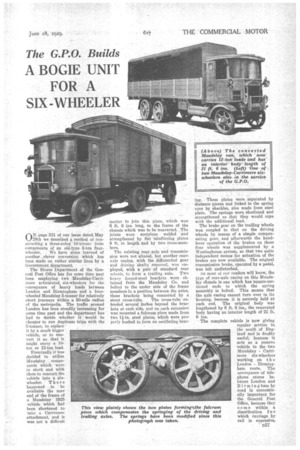The G.P.O. Builds
Page 89

If you've noticed an error in this article please click here to report it so we can fix it.
A BOGIE UNIT FOR A SIX-WHEELER
ONpage 531 of our issue dated May 2Sth we described a method of constructing a three-axled 10-tonner from components of an old-type 5-ton four
wheeler. We have since learned of another , clever conversion which has been made on rather similar lines by a Government department.
The Stores Department of the General Post Office has for some time past been employing two Maudslay-Carrimore articulated, six-wheelers for the conveyance of heavy loads between London and Birmingham and a fourwheeled Mandalay 5-tonner for relatively short journeys within a 50-mile radius of the metropolis. The traffic around London has been steadily increasing for some time past and the department has had to decide whether it would be cheaper to run duplicate trips with the 5-tonner, to replace' it by a much bigger vehicle, or to convert it so that it might carry a 10ton or 12-ton load.
Eventually it WAS decided to utilize Maudslay components which were in stock and with them to convert the vehicle into a sixwheeler. There happened to be. available the rear end of the frame of a Mandalay 1925 vehicle which had been shortened to take a Carrimore attachment, and it was not a difficult
matter to join this piece, which was 6 ft. 6 ins, long, to the frame of the chassis which was to be converted. The joints were acetylene welded and strengthened by flat iiinf6reing plates 9 ft. in length and by two Cross-members.
The existing rear axle and transmission were not altered, but another rearaxle casing, with the differential gear and driving shafts .removed, was employed, with a pair of standard rear wheels, to form a trailino. axle. Two heavy forged-steel brackets were obtained from the Mandslay Co. and bolted to the under side of the frame members in a position between the axles, these brackets being connected by a stout cross-tube. The cross-tube extended several inches beyond the brackets at each side, and on each extension was mounted a fulcrum piece made from two 11-in, steel plates, which were properly bushed to form an oscillating bear
lug. These plates were separated by distance pieces and linked to the spring eyes by shackles, also made from steel plate. The springs were shortened and strengthened so that they would cope with the additional load.
The brake gear on the trailing wheels was coupled to that on the driving wheels by means of a simple compensating gear, and afterwards the handlever operation of the brakes on these four wheels was supplemented by a Westinghouse system, so that two quite independent means for actuation of the brakes are now available. The original transmission brake, operated by a pedal, was left undisturbed.
AS most of our readers will know, the type of rear-axle casing on this Maudslay chassis is one which has 'square-sectioned ends to which the spring assembly is bolted. This means that the axle casing cannot turn over in its housing, because it is securely held at each end. The original body was lengthened by 6 ft. 6 ins., the renovated body having an interior length of 21 ft. 6 ins.
The complete vehicle is now giving regular service in the south of England and is doubly useful, because it acts as a reserve vehicle to the two Mandalay Carrimore six-wheelers working on t h e London Birmingham route. The conveyance of telephone stores between London and Birmingham by road is economically important for the General Post Office, because they come within a classification f o r which carriage by rail is expensive. Ithe fulcrum driving and d since this








































































































































































































